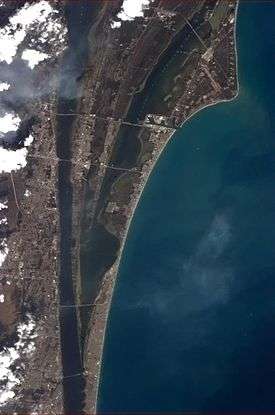Space Coast
The Space Coast is a region in the U.S. state of Florida around the Kennedy Space Center (KSC) and Cape Canaveral Air Force Station. All of NASA-launched crewed spaceflights (running from Project Mercury in 1961 to and from the end of the Space Shuttle program in 2011) have departed from either KSC or Cape Canaveral. The Air Force Station has also launched unmanned military and civilian rockets. Cities in the area include Titusville, Cocoa, Rockledge, Cape Canaveral, Merritt Island (unincorporated), Cocoa Beach, Melbourne, Indialantic, Palm Bay, and Viera (unincorporated). Most of the area lies within Brevard County. It is bounded on the south by the Treasure Coast, on the west and north by Central Florida (and is economically tied to that region), and on the east by the Atlantic Ocean.


One reason rockets are launched in Florida has to do with the Earth's rotation. The Earth rotates most quickly at the equator, and to take advantage of this, in adding to the orbital velocity of the rocket, it is most beneficial to launch from a southerly location (near the equator). In addition, to take advantage of the direction of rotation of the planet, launching from a location on an easterly coast where there is no inhabited population where debris would land in an emergency would be ideal for both the safety of the people on the ground and for fuel efficiency of the rocket. The only locations in the United States capable of this are on the east coasts of Florida, Texas, and Puerto Rico, but given the high population densities in coastal Texas, South Florida, and Puerto Rico, the Space Coast is often considered the best location when all factors are taken into account.
Space-named landmarks (outside KSC and Cape Canaveral Air Force Station)
Many places near the Cape are named for subjects relating to the US space program including vehicles, astronauts, and the spaceport itself.
- Alan Shepard Park, Cocoa Beach
- Apollo Boulevard, Melbourne
- Apollo Elementary School, Titusville[1]
- Armstrong Drive, Titusville
- Astronaut Boulevard, Cape Canaveral
- Astronaut High School, Titusville
- Atlantis Elementary School, Port St. John[2]
- Bayside High School, Palm Bay
- Challenger 7 Elementary School, Port St. John
- Challenger Memorial Parkway, (State Road 407), Titusville
- Chaffee Drive, Titusville
- Christa McAuliffe drawbridge, Merritt Island
- Christa McAuliffe Elementary School, Palm Bay
- Columbia Boulevard (State Road 405), Titusville
- Columbia Elementary School, Palm Bay
- Columbia Village, Melbourne (Florida Institute of Technology)
- Discovery Elementary School, Palm Bay[3]
- Endeavour Elementary Magnet school, Cocoa[4]
- Enterprise Elementary School, Cocoa
- Freedom 7 Elementary School, Cocoa Beach
- Gemini Elementary School, Melbourne Beach[5]
- Grissom Parkway, Cocoa
- I Dream Of Jeannie Drive, Cocoa Beach
- John F. Kennedy Middle School, Rockledge
- Jupiter Boulevard, Palm Bay
- Kennedy Point Park, Titusville
- MILA Elementary School, Merritt Island[6] (an abbreviation for "Merritt Island Launch Area")[7]
- Minutemen Causeway, Cocoa Beach
- NASA Boulevard (State Road 508), Melbourne
- Ronald McNair Middle Magnet School, Rockledge
- Satellite Beach, Florida
- Satellite Boulevard, Cocoa
- Satellite High School, Satellite Beach
- Shepard Drive, Titusville
- Space Coast Jr./Sr. High School
- Space Coast Stadium, Viera, Florida
- Space Coast Surge, a member of the Florida Winter Baseball League played out of Cocoa in 2009[8]
- Space View Park, Titusville
- White Drive, Titusville
Telephone area code
When the region became too heavily populated to be served by only one area code, a local resident Robert Osband (aka Richard Cheshire)[9] discovered that area code 321 was not assigned to any other territory (though it was being considered for the suburban Chicago area).[notes 1] If each number is pronounced individually—"3, 2, 1"—the pronunciation resembles the countdown before liftoff; thus, the resident petitioned for the code to be assigned to the Space Coast region. His efforts were popular among local residents and resulted in success; the new code officially became effective on November 1, 1999.[10][11]
Tourism
The local area is popular with visitors to watch rocket launches in person. Over 100,000 people are believed to have been present in February 2018 for the Falcon Heavy test flight.[12]
Notes
- This includes most of the county except the Southern portion.
References
- "Apollo Elementary School". Retrieved 11 August 2017.
- "Atlantis Elementary School" (PDF). Retrieved 14 June 2018.
- "Discovery Elementary School". Retrieved 11 August 2017.
- "Endeavour Elementary Magnet: About Us". Retrieved 11 August 2017.
- "Schools Listing". Archived from the original on 23 March 2013. Retrieved 11 August 2017.
- "Mila Elementary School". Retrieved 11 August 2017.
- Saggio, Jessica (August 11, 2015). "So what does the name MILA Elementary actually mean?". Florida Today. Melbourne, Florida. p. 1B. Retrieved August 11, 2015.
- "spacecoastsurge.com - spacecoastsurge Resources and Information". www.spacecoastsurge.com. Archived from the original on 3 February 2015. Retrieved 11 August 2017.
- http://cheshirecatalyst.com/321.html
- Osband, Robert. "Spacey Ideas - A Chronology of Events regarding Area Code 321". spaceyideas.com. Retrieved 11 August 2017.
- "Countdown Starts For New Area Code On Space Coast". 18 January 2000. Archived from the original on 18 January 2000. Retrieved 11 August 2017.
- https://eu.floridatoday.com/story/tech/science/space/2018/06/05/spacex-air-force-targeting-fall-next-falcon-heavy-launch-ksc-florida/669651002/
